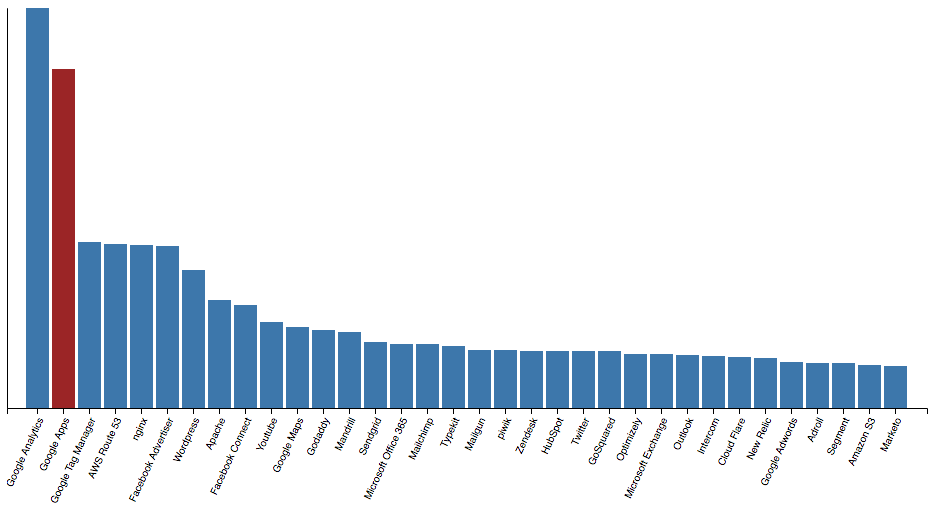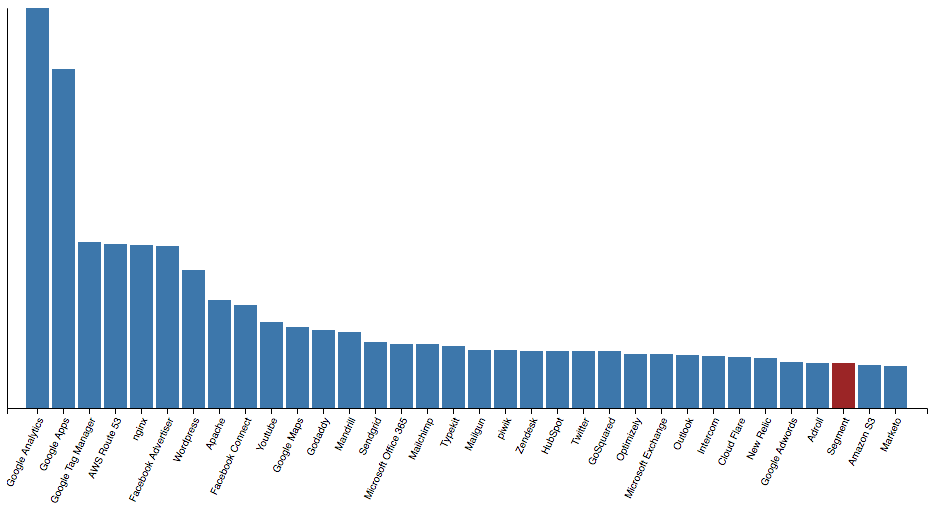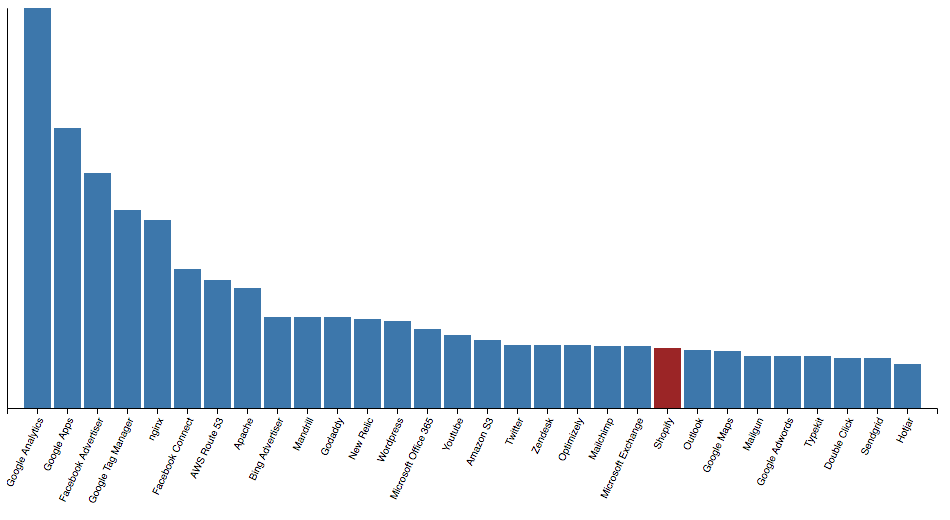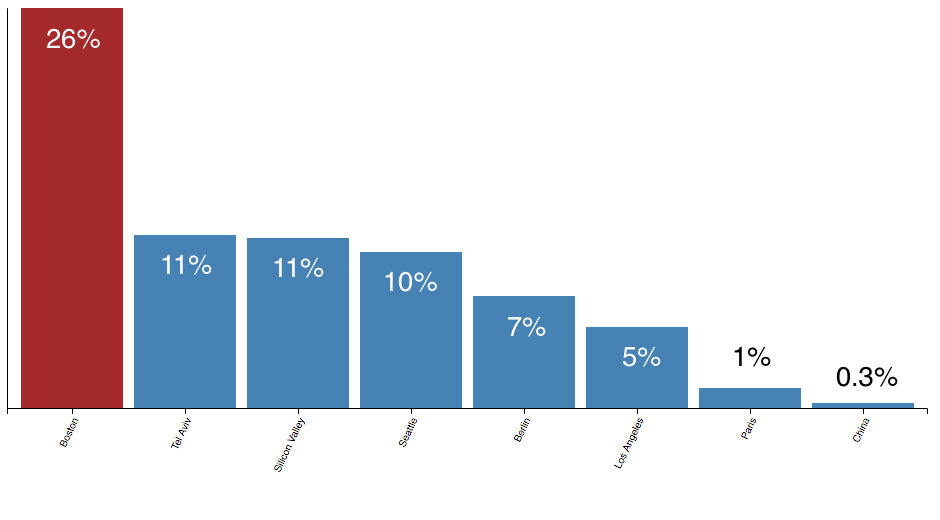The software integrations you should be building
Each year, 85 million startups are born. That's 3.17 startups every second. So if you want to build an integration, where on earth do you start? Using our Clearbit tech tags, we peeked under the hood of the smartest companies to see which technologies they run off. From startups in San Francisco to conglomerates in China, we sought to uncover which tech offers the best opportunities for integration, so you can access brand new markets and thousands of potential customers.
Best All-Around Integration: G Suite
Google Apps vied for the top spot in virtually every data set we analyzed. When we put all our data together, it was the second most common tech overall after Google Analytics:

This shouldn't be surprising: G Suite recently announced that they have over 4 million paying customers a figure that's almost doubled since the company vowed to make inroads into the enterprise. That progress is backed up by our data, with Google Apps proving popular for company sizes ranging from $1M ARR to more than $10B. The only exception was China where Google Apps was relegated to the sixth spot (still impressive in a country where much of the G Suite is banned).
Google Chrome accounts for 60% of the total web browser market, and the Chrome Web Store makes it easy to offer lightweight add-on services to complement Gmail, Google Drive and other Google Apps. Our own email-finder Gmail integration is now one of our most valuable lead-gen sources.
Whether you build entirely on Google Apps or just complement your main product with an add-on, integrating with G Suite allows you to get your product in front of a massive number of users in their natural workflow.
Get started with the G Suite integration
Best Marketing and Sales Integrations: HubSpot and Salesforce
For companies below $250M ARR, HubSpot is the most popular choice for marketing automation, dwarfing industry rivals Marketo and Pardot.
But as companies grow larger, their needs change, and in turn, the tools they are using. HubSpot is the market leader, but predominantly at the lower end of the market. The landscape changes for companies with greater than $250M ARR, with Eloqua becoming more common in this market:

For companies targeting all but the largest of organizations, integrating with HubSpot provides the opportunity to embed your product into the heart of your user's marketing workflow. The deal is sweetened by the extra exposure offered by HubSpot Connect, the company's own marketplace of integrations.
For sales-focused companies, Salesforce is the go-to integration, with Pipedrive a distant second - mirroring Salesforce's position as the world's most popular CRM, accounting for around 20% of market share. Companies as varied as Adobe Sign and FedEx have taken advantage of the company's bustling AppExchange marketplace, using integrations to earn exposure to Salesforce's huge customer base.
Get started with the HubSpot integration or Salesforce integration
Best Data Integration: Segment
We saw a lot of data analytics tools during our analysis. Everyone uses Google Analytics, but Mixpanel, New Relic, Amplitude, and Matomo were all also heavily used. The most common in our dataset was Piwik, now Matomo, but there was a tool also commonly used that is purpose-built for easy integrations - Segment:

Segment is a hub for customer data that can link to 200+ other products. Through a single Segment integration, we can send Clearbit’s data to Appcues for personalized onboarding, Customer.io for really targeted email campaigns or Hubspot to enrich your CRM contacts. It's our favorite integration because it opens so many doors.
Get started with the Segment integration
Best E-commerce Integrations: Shopify and WooCommerce
For e-commerce products looking to build out mutually beneficial integrations, two opportunities stand out. Shopify - the all-in-one e-commerce platform with an estimated $169B market cap - was a common occurrence, coming up relatively high in the rankings for companies around the world.
When we looked at only e-commerce companies, it was one of the most prevalent technologies used:

Integrating with Shopify provides access to the Shopify App Store, a dedicated integrations marketplace catering to over 600,000 merchants. User-generated content curation platform Yotpo used the app store to great effect, garnering 14,000 additional users from their Shopify integration alone.
Our analysis showed WooCommerce - a WordPress-specific e-commerce platform - is hot on Shopify's heels. The company powers over 30% of the world's online stores and offers its own marketplace for integrating services that companies as large as HubSpot have leveraged as an additional growth channel.
Get started with the Shopify integration or WooCommerce integration
Best CMS Integration: WordPress
Most companies rely on their websites for lead generation, sales and support, and at the heart of every website lies a Content Management System (or CMS). Powering over 28% of the world's websites, it's no surprise that WordPress was the most popular CMS, with Drupal and Joomla! taking second and third.

With so many companies relying on the CMS, creating a WordPress plugin provides a low-friction route towards product adoption, allowing new users to add your product to their core infrastructure in a couple of clicks. Personalization platform AddThis has leveraged WordPress to drive installation on over 15 million domains.
Enterprise companies were the exception to the rule: Businesses generating more than $500M in ARR show a preference for Drupal over WordPress, with Joomla! dropping out of the tech stack completely.
Get started with the WordPress integration.
Keeping integrations in the family: Boston and Y Combinator
Our dataset included companies from startup hubs across the world. We also used data from hubs in China, Paris, Tel Aviv, Berlin, Silicon Valley, Seattle, Los Angeles and Boston.
We had a closer look at the breakdown of tech used by Boston-based companies as an experiment:
Within the top 30 technologies used by Boston companies, three are from other Boston companies. Hubspot, Drift and Wistia are all over-represented in the Boston cohort.
If we dive deeper into HubSpot, breaking down the data by hub location, the dominance is obvious:

Over one-quarter of companies we analyzed in the Boston area are using HubSpot. The same trend was true of Drift and Wistia. Both are used by about 10% of Boston companies, but by only 1-3% of companies in the other hubs.
So if you are in Boston, integrating with Hubspot, Drift and Wistia will get your product in front of your local peers.
You can see the same idea with Y Combinator companies. We called this the Y Combinator Ouroboros in our previous Y Combinator analysis. From the top 30 technologies used by Y Combinator companies, 20% are other YC startups. If you are in YC and want to appeal to the 1,500 companies that have come before you, making sure you have a Segment integration is a must.
The Take-away
There's a simple truth at the heart of this: the easier your product is to integrate, the easier it is to adopt. No application lives in a silo, and the integrations you build are just as important as the native features you offer. Our findings should make it easier to identify the core integrations you should be building and boost your product's user experience and reach.

